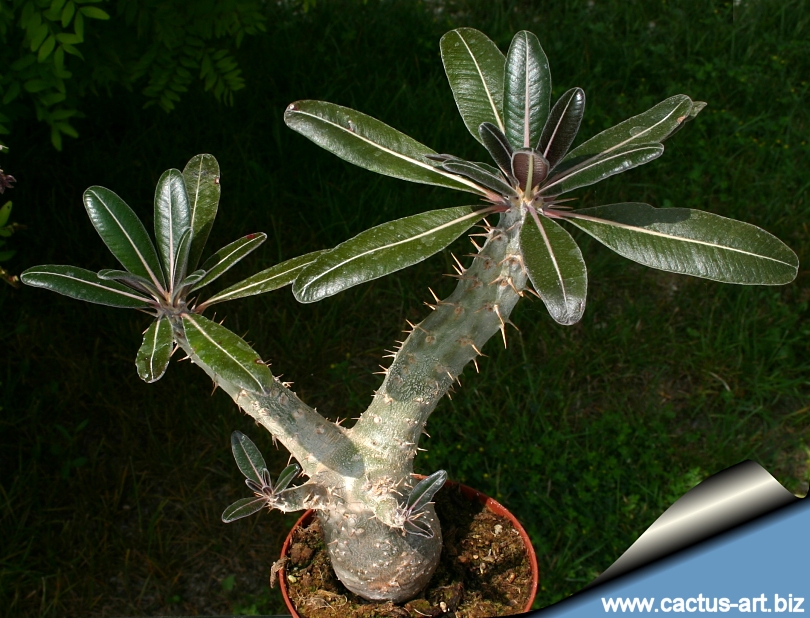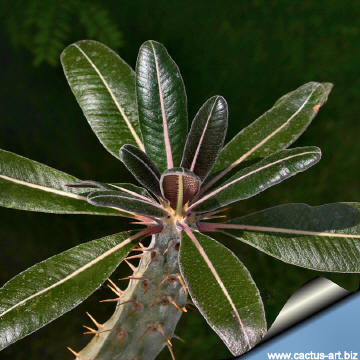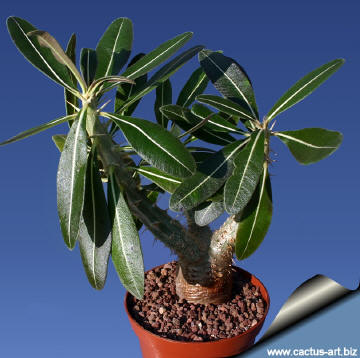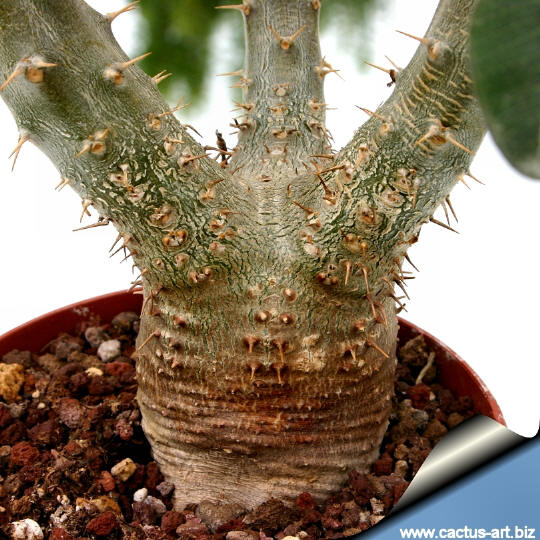|
|
|

Pachypodium rosulatum
This species has short and thick succulent caudex branching into
cylindrical arms with stout spines, and topped by a rosette of narrow
oblanceolate leaves, and long-stalked sulphur-yellow flowers.
|
|
Description: It is a wide spread and variable
shrubby caudiciform species with several recognized forms and variety.
It has (usually) the classic bottle-shaped trunk and is heavily thorned
like most other pachypodiums.
Stem: The base (caudex) is smooth or with leaf scars, greenish
silver, mostly spineless, bottle shaped and becomes quite swollen (10-15
cm wide and 25-30 cm tall) It develops stout forked branching mostly
upright with some branching occurring from the lower base. Braches 9-12
cm in diameter, branchlets, often thin pale-brown and pubescent at the
apex. The cylindrical "arms" are covered with stout paired conical
spines, crown up to 3 x 2 m. Branching occurs where the plant has
flowered.
Leaves: Petiolate (petiole 1-10 mm long) narrow oblanceolate,
ovate or elliptical, cuneate at the base and dark green with a bit of a
glossy look on the upper face, pubescent, coriaceous, deciduos. The
leaves have a lighter middle vein and form a rosette around the tips of
branches.
Flowers: The type plant has vivid yellow, oddly shaped , no
scented flowers in clusters on long peduncles towards the top of the
stems. The blooms can exceed 7 cm in diameter and are very attractive.
Blooming season: Blooms when young from February 'til May , even
small 1 or 2 year old plants may flower.
Pachypodium cactipes may merely represent a southerly form of the
Pachypodium rosulatum complex but for now it is preferred
to recognize it as a distinct species until further research clarifies
its affinities. Its rich green glossy foliage, showy yellow flowers and
ease of culture make it one of the more rewarding of the genus.
|
 |
 |
|
Culture: Pachypodium rosulatum is one of the most widely
cultivated of the species and of relatively easy culture. It presents
little difficulty if compared to other member of the genus, but it is
anyway prone to rot if allowed to get too wet in winter or if cultivated
under less than ideal conditions and care. It is moderate grower, but an
impressive specimen with a big caudex can be made fast. Water sparingly
in summer and give extra well-drained soil to avoid waterlogged
conditions, no water from November to March. The watering program will
change depending on temperatures and stage of growth, but it is best not
to let this plant dry out completely for any length of time. It is
sensitive to cold and should be kept totally dry in winter at or
around 4░C. Protect from frost. It tends to lose its leave and go
dormant in winter. It like
full sun to light shade .
Reproduction: Seeds. Seedlings grow fairly slowly
compared to other Pachypodium species. Young plants have more conical
spines and begin early to swell nicely, branch and even flower. |
|
Advertising
|
|
|
|
Family: Apocynaceae
|
|
Scientific name:
Pachypodium rosulatum
Baker
in Journ. Bot. 20: 219 (1882)
Origin: Madagascar. Pachypodium rosulatum was the
first of the Malagasy species to be. described. It is widely distributed
on the central plateau.
Habitat: Usually found in sunny positions on stony places
where they are associated with other representatives of the flora of dry
areas. This species can tolerate subzero temperatures in its natural
environment in winter. They are found in xeric habitats and are
naturally well adapted to the hot and dry environment in which they
grow. The succulent stems act as water stores and enable the plants to
survive the harshest conditions. The thick tuberous underground stems
also help the plants to survive long periods without water. They can
therefore withstand intense heat and long periods of drought.
Conservation status: Listed in
CITES appendix 2.
Common Names include: Elephant's Foot Plant
|
|
Synonyms:
- Pachypodium cactipes K. Schum. 1895.
- Pachypodium drakei Costantin & Bois
In: Ann.Sc. Nat. sÚr. 9,6:319 1907.
- Pachypodium rosulatum drakei (Costantin & Bois )
Marckgr.
In: Adansonia sÚr. 2, 12: 590 1972
|
|
|
|

This is one of the most beautiful blooming
succulents that has become an anchor plant in many collections and has
always been prized by collectors.
Photo of conspecific taxa, varieties, forms and
cultivars of plants belonging to the
Pachypodium rosulatus
complex
(This
Taxon
has several controversial varieties and subspecies and comprises a multitude of different forms, but where each form
is linked to others by populations of plants with intermediate
characteristics):
|
|

 |
|